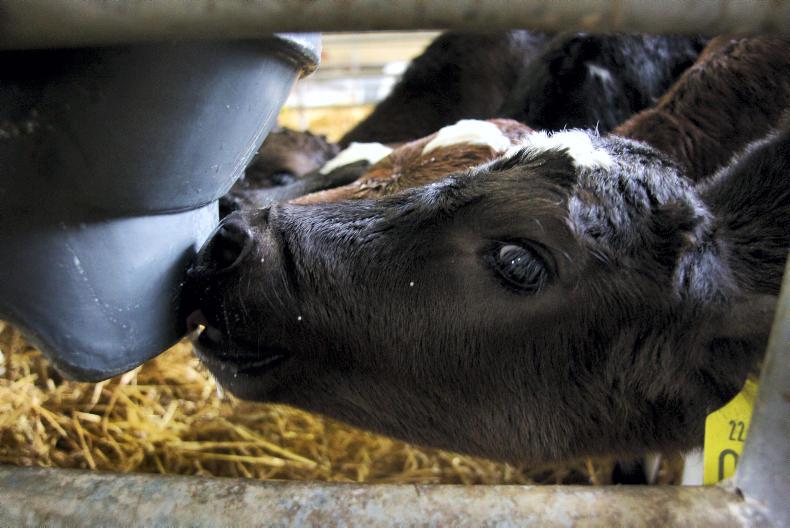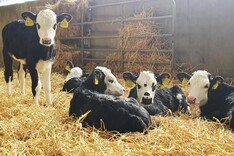1. Colostrum is gold
Newborn calves require 3l of colostrum (or 10% of bodyweight) within two hours of birth. This is to ensure transfer of immunity from dam to calf. It is also full of essential nutrients which provide energy for the calf to grow. Insufficient colostrum will leave the calf open to infections and will be a likely cause of poor thrive over its lifetime. Farmers who buy calves in the mart from a seller they are not familiar with are leaving themselves exposed to the possibility that the calf got insufficient colostrum. While most dairy farmers will strive to ensure all calves get enough colostrum, there are studies to show that calves left to suckle cows are 2.4 times more likely to have insufficient antibodies. If possible, buy calves from farmers who you know have a good colostrum management policy.
2. Limit the source
If at all possible, try to buy calves from as few sources as possible. The more farms that calves come from, the more chance of different diseases coming into your yard. In an ideal scenario, all the calves would be purchased from one source and kept together, away from other animals on your farm. The highest risk period for calf health is pre-weaning, so limiting contact with other animals during this time is a good preventative technique. If calves have to be sourced from multiple sources, keep them in separate pens and clean feeders between pens.
3. House well
There is some debate about the best type of shed for calves. Whatever the design, it should provide the following; a clean and dry lie, good ventilation with fresh air replacing stale air frequently and be free from draughts. Very few calf sheds on Irish farms are actually designed with calves in mind, which leads to wet beds, poor ventilation and respiratory disease in calves.

4. Feed milk
It is common for farmers to feed electrolytes to calves on the day they arrive on farm. This is good practice, as electrolytes will rehydrate calves and replenish electrolytes lost through scour. However, they are not a replacement for milk. Even when feeding electrolytes as treatment for scour, milk should still be fed at normal rates. Otherwise, the calf will be undernourished as well as dehydrated from scour.
5. Pick a good milk replacer
There are many different types of milk replacer products on the market, with varying levels of protein and oils. The main things to look out for are the source of proteins. Wheat- or plant-based proteins tend to be less digestible than dairy-based proteins. Crude fibre levels greater than 0.15% tend to indicate the inclusion of plant-based proteins in the milk replacer.

6. Feed milk economically
The margins in a dairy calf to beef system are tight. Milk replacers are an expensive feed. Therefore, they should be fed economically. It is true to say that the calf’s feed conversion efficiency is highest when on milk, but that doesn’t mean it is more profitable to feed more milk, particularly not when the system requires finishing off grass, ie not veal production. In my view, a milk replacer feeding rate of 600g to 700g of powder per calf per day is sufficient for most calves.
7. Feed once a day
After a few weeks, calves can be fed once a day. Farmers find that calves fed once a day will eat more meal, require less labour input and are easier to wean. Because they eat more meal, they can be fed less milk too, reducing milk replacer costs.
8. Always give calves access to clean water and meal

9. Wean on weight
Not all calves thrive at the same rate. Therefore, calves should be weaned based on weight and size rather than just age. The weight to wean at will depend on preferences. If weaning at weights lighter than 100kg, then ad-lib meal should be offered. Calves should be weaned gradually, over the space of a week. Put calves on once-a-day feeding and reduce the amount of milk being offered daily.

10. Mix correctly
When mixing milk replacer, calculate the total amount of feed you need. For example, if you are feeding 10 calves 2l of milk, you need 20l of mixed milk in total. If the feeding rate is 15%, the calves need to get 300g of powder each at each feed, or 3kg of powder for the bunch. Because milk powder will displace water, you should reduce the amount of water used by the quantity of powder. So instead of mixing 3kg of powder into 20l of water, you should mix 3kg of powder into 17l of water to make 20l of mixed milk. When mixing, pour the correct amount of milk powder into half the desired amount of water and mix with a whisk or other mixing device. Then add the rest of the water. Never mix with boiling water as this could corrupt the proteins. Only ever mix and feed with water at or below body temperature. Milk replacer can be successfully fed cold.
This article is taken from the Feed Guide magazine, which is available to buy here. Read more:
Watch: tidy parlour and TAMS frustrations
Dairy management: fodder scarcity and losing body condition score
1. Colostrum is gold
Newborn calves require 3l of colostrum (or 10% of bodyweight) within two hours of birth. This is to ensure transfer of immunity from dam to calf. It is also full of essential nutrients which provide energy for the calf to grow. Insufficient colostrum will leave the calf open to infections and will be a likely cause of poor thrive over its lifetime. Farmers who buy calves in the mart from a seller they are not familiar with are leaving themselves exposed to the possibility that the calf got insufficient colostrum. While most dairy farmers will strive to ensure all calves get enough colostrum, there are studies to show that calves left to suckle cows are 2.4 times more likely to have insufficient antibodies. If possible, buy calves from farmers who you know have a good colostrum management policy.
2. Limit the source
If at all possible, try to buy calves from as few sources as possible. The more farms that calves come from, the more chance of different diseases coming into your yard. In an ideal scenario, all the calves would be purchased from one source and kept together, away from other animals on your farm. The highest risk period for calf health is pre-weaning, so limiting contact with other animals during this time is a good preventative technique. If calves have to be sourced from multiple sources, keep them in separate pens and clean feeders between pens.
3. House well
There is some debate about the best type of shed for calves. Whatever the design, it should provide the following; a clean and dry lie, good ventilation with fresh air replacing stale air frequently and be free from draughts. Very few calf sheds on Irish farms are actually designed with calves in mind, which leads to wet beds, poor ventilation and respiratory disease in calves.

4. Feed milk
It is common for farmers to feed electrolytes to calves on the day they arrive on farm. This is good practice, as electrolytes will rehydrate calves and replenish electrolytes lost through scour. However, they are not a replacement for milk. Even when feeding electrolytes as treatment for scour, milk should still be fed at normal rates. Otherwise, the calf will be undernourished as well as dehydrated from scour.
5. Pick a good milk replacer
There are many different types of milk replacer products on the market, with varying levels of protein and oils. The main things to look out for are the source of proteins. Wheat- or plant-based proteins tend to be less digestible than dairy-based proteins. Crude fibre levels greater than 0.15% tend to indicate the inclusion of plant-based proteins in the milk replacer.

6. Feed milk economically
The margins in a dairy calf to beef system are tight. Milk replacers are an expensive feed. Therefore, they should be fed economically. It is true to say that the calf’s feed conversion efficiency is highest when on milk, but that doesn’t mean it is more profitable to feed more milk, particularly not when the system requires finishing off grass, ie not veal production. In my view, a milk replacer feeding rate of 600g to 700g of powder per calf per day is sufficient for most calves.
7. Feed once a day
After a few weeks, calves can be fed once a day. Farmers find that calves fed once a day will eat more meal, require less labour input and are easier to wean. Because they eat more meal, they can be fed less milk too, reducing milk replacer costs.
8. Always give calves access to clean water and meal

9. Wean on weight
Not all calves thrive at the same rate. Therefore, calves should be weaned based on weight and size rather than just age. The weight to wean at will depend on preferences. If weaning at weights lighter than 100kg, then ad-lib meal should be offered. Calves should be weaned gradually, over the space of a week. Put calves on once-a-day feeding and reduce the amount of milk being offered daily.

10. Mix correctly
When mixing milk replacer, calculate the total amount of feed you need. For example, if you are feeding 10 calves 2l of milk, you need 20l of mixed milk in total. If the feeding rate is 15%, the calves need to get 300g of powder each at each feed, or 3kg of powder for the bunch. Because milk powder will displace water, you should reduce the amount of water used by the quantity of powder. So instead of mixing 3kg of powder into 20l of water, you should mix 3kg of powder into 17l of water to make 20l of mixed milk. When mixing, pour the correct amount of milk powder into half the desired amount of water and mix with a whisk or other mixing device. Then add the rest of the water. Never mix with boiling water as this could corrupt the proteins. Only ever mix and feed with water at or below body temperature. Milk replacer can be successfully fed cold.
This article is taken from the Feed Guide magazine, which is available to buy here. Read more:
Watch: tidy parlour and TAMS frustrations
Dairy management: fodder scarcity and losing body condition score










 This is a subscriber-only article
This is a subscriber-only article














SHARING OPTIONS: